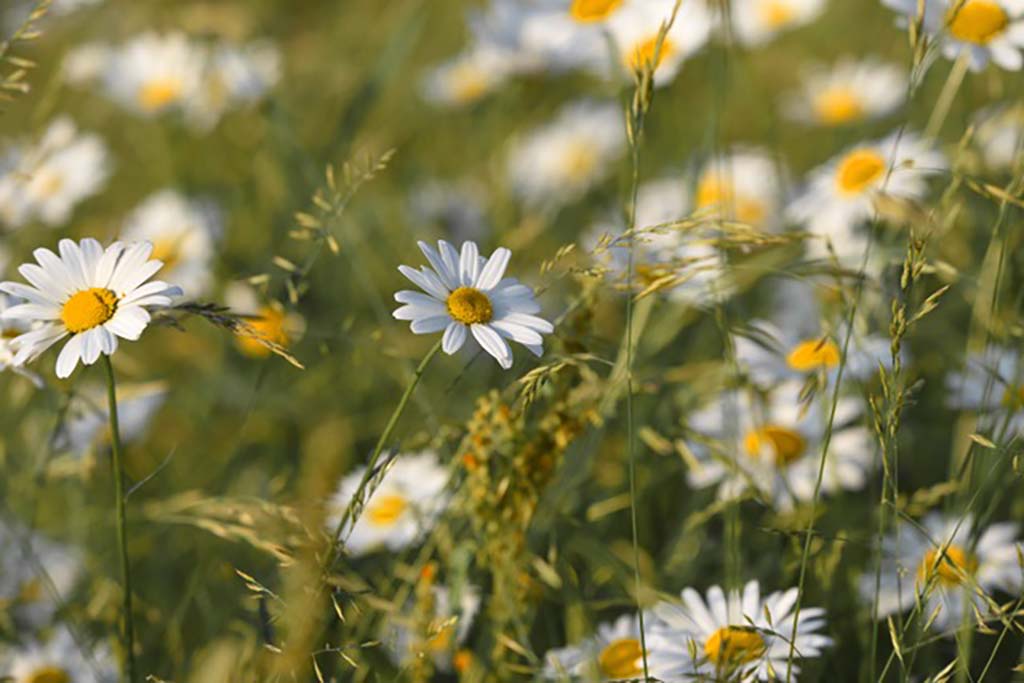
Latvia
Daisy
Leucanthemum vulgare

General Description / Cultural Significance
Latvia is an Eastern European country facing the Baltic Sea. It has high biodiversity throughout its rolling hills, forests, grasslands, bogs, and meadows. Among its hundreds of native flower species, the Daisy, Leucanthemum vulgare, is the one most cherished by the Latvian people. Known as the Pīpene, the flower symbolizes the roots of the Latvian country. The Daisy grows one meter (three feet) tall and quickly spreads. It has a long blooming season, so it is woven into celebrations throughout the year. Adorning women and children as headpieces and necklaces, the flower is a joyful part of weddings and is used to console those who have lost loved ones.
Once growing everywhere and used in food and medicine for centuries, Daisy flower heads and leaves are harvested to dry for year-round use. Daisy petals, high in Vitamin C, are common, nutritious additions to salads, soups, and seasonings. The whole plant is made into an anti-inflammatory tea that tastes lemon-like and is used as a remedy for everything from eye irritations to coughs, asthma, and anxiety. The leaves are utilized externally as an astringent to treat skin conditions from wounds to ulcers and as a blood purifier. However, its reputation as a restorative, healing plant transcends these specific uses.
Climate Change / Conservation Status
Oxeye Daisies have increasingly lost their habitat due to intensive agriculture. However, the plant still persists on banks and roadsides and continues to decorate the gardens of Latvian manor houses, as it has since the beginnings of the concept of gardens. Since Latvia was a part of the Soviet Union, factories have poured high levels of pollutants into the country’s water sources and soil. Industries continue to generate tremendous air and water pollution from the harmful chemicals they use such as petroleum products, sulfur dioxide, and formaldehyde. Additionally, lack of waste water treatment facilities in Latvia contribute to the nation’s water pollution, contaminating the water with high levels of bacteria. Life under Latvia’s air is further stressed as acid rain is killing the country’s forests and other vegetation. Even though the country is distressed by this, financial struggles make it hard to install what is necessary to control emission levels.
The IUCN reports that a high percentage of vascular plants in Latvia are under threat. Despite its decline in numbers, Leucanthemum vulgare is thought to be stable in Latvia, possibly due to its general hardiness, wind tolerance, ability for self-fertilization, and competitiveness within its ecosystems, both producing a large number of seeds and having the ability to regenerate from rhizome fragments.
Alternate Names
Oxeye Daisy
Pīpene
Sources
The Baltic Sea States Environment, 2013. Environmental issues in Latvia. Baltic21.org. [website]
CABI, 2019. Leucanthemum vulgare (oxeye daisy). CAB International. [website]
Latvia, 2021. Symbols. Investment and Development Agency of Latvia. [website]
Mission of the Republic of Latvia to the United Nations. This statement can be found on the World Sensorium original website.
Nations Encyclopedia, 2022. Latvia – Environment. Advameg, Inc. [website]
Pickup Flowers, 2022. National, Native, Popular Flowers of Latvia. Pickup Flowers. [website]
Pino del Carpio, A., et al., 2013. Latvia’s biodiversity at risk. IUCN. [website]

